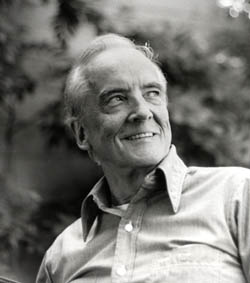My own interest . . . concerns deliberate aesthetic preference . . . for architecture which translates the spirit of places into forms which are habitable. – John Yeon
John Yeon (1910-1994) is nationally regarded as a regional pioneer in the fundamental rethinking of art and architecture for the twentieth century. A native Oregonian, largely self-taught, his brilliant designs include buildings, interiors, gardens, landscapes, furnishings, and museum installations.
Yeon worked tirelessly to preserve and enhance the landscape of the Northwest. At age 21 he was appointed by Governor Julius Meier to Oregon’s first State Park Commission; a few years later he served as chair of the Columbia Gorge Committee of the National Resources Board and wrote its report, a proto-“environmental impact study” on the likely effects of Bonneville Dam. He actively promoted the creation of the Olympic National Park. For more than six decades, he was a powerful advocate for landscape preservation, civic planning, and urban and rural parks. Additionally, he was a lifelong, passionate, and often lonely voice calling for the preservation of the Columbia River Gorge.
Yeon’s best-known architectural work is the Watzek House (1937), built of native woods and exquisitely detailed, designed when he was 26 years old. Sited high in Portland’s west hills, it is aligned to a spectacular view of Mt. Hood. Photographs of the house were shown at New York’s Museum of Modern Art in 1938 and later featured in subsequent exhibitions and MOMA publications including the book, Built in USA – 1932-1944. This early exposure brought international interest in Yeon’s work, which, along with the work of his contemporary, Pietro Belluschi, became known as the Pacific Northwest regional style. In May 1986, Yeon discussed his design philosophy during an appearance at the University of Washington in the only formal lecture he ever gave about his work: “My own interest is very limited; it concerns deliberate aesthetic preference for forms sympathetic to various natural landscapes, or, in a high-flown phrase I used when I was young, ‘architecture which translates the spirit of place into forms which are habitable.'”
Of regional architecture, he said it “does not happen simply, automatically, or unself-consciously as it once did. If it happens at all, it results from deliberate aesthetic resistance to ubiquitous popular fashions. It will be done by people and for people who love landscapes and are literate in architecture…It is my belief that significant regional architecture will be an act of will, an act of taste, a response triggered by an appreciation of nature.”
Yeon also had a passion for art, which led, in his later years, to a focus on museum galleries and art installations. Among his designs are several galleries and a wing interior at the Nelson-Atkins Museum in Kansas City, the original installation of the Avery Brundage Collection in San Francisco, and several galleries at the Portland Art Museum. His own collection – one of the most important collections of decorative art on the West Coast – included Chinese, Japanese, Korean, and Indian art, as well as decorative arts of eighteenth-century Europe.

